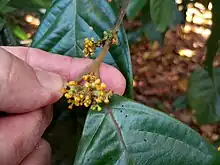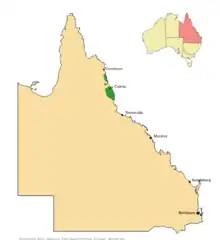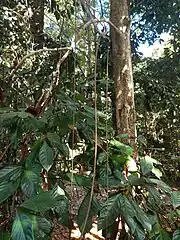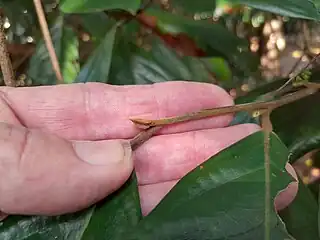Endiandra sankeyana
Endiandra sankeyana, commonly known as Sankey's walnut, is a plant in the laurel family Lauraceae that was first described in the late 19th century. It is endemic to Queensland, Australia, where it grows in that state's northeastern coastal rainforests.
| Sankey's Walnut | |
|---|---|
 | |
| Inflorescence | |
| Scientific classification | |
| Kingdom: | Plantae |
| Clade: | Tracheophytes |
| Clade: | Angiosperms |
| Clade: | Magnoliids |
| Order: | Laurales |
| Family: | Lauraceae |
| Genus: | Endiandra |
| Species: | E. sankeyana |
| Binomial name | |
| Endiandra sankeyana | |
 | |
Description
Sankey's walnut is an evergreen canopy tree growing up to 30 m (98 ft) high, and the trunk may be buttressed.[5][6][7] The leaf bearing twigs are angular or fluted and covered in a fine indumentum. The leaves are dark green above and somewhat glaucous below with a petiole up to 18 mm (0.71 in) long.[5][6][7] They are lanceolate to elliptic to more or less obovate, and measure up to 17 by 9.5 cm (6.7 by 3.7 in).[5][6][7]
The much branched inflorescences are produced in the leaf axils and carry dozens of very small, fragrant, golden-yellow flowers about 2–3 mm (0.079–0.118 in) wide.[5][6][7] The fruit is a globose to ellipsoidal blue drupe, measuring up to 54 by 41 mm (2.1 by 1.6 in) and containing a single seed.[5][6][7]
Taxonomy
This species was first described in 1893 by the Australian botanist Frederick Manson Bailey, and published in Botany Bulletin, a journal published by the then Queensland Department of Agriculture.[3] Bailey's description was based on material collected by E. Cowley in "scrubs of the Barron River".[3]
Etymology
The genus name Endiandra is formed from "endo" meaning inner or inside, and "andro" meaning male, which is a reference to the inner series of anthers being fertile.[7] The species epithet sankeyana was chosen to honour J. R. Sankey.[7]
Distribution and habitat
Endiandra sankeyana is found from the Cooktown region in the north to the area near Mission Beach in the south,[5][6] with a single recorded sighting another 90 km (56 mi) further south near Ingham.[8] It grows at elevations from sea level to around 1,300 m (4,300 ft), in mature rainforest on a variety of soils.[5][6][7]
Ecology
Fruits of this species are eaten by Musky rat-kangaroos and cassowaries,[6] both of which are recognised as important seed distributors for numerous species of plants.[9] They are also eaten by native rodents.[7]
Conservation
This species is listed by both the Queensland Department of Environment and Science and the International Union for Conservation of Nature (IUCN) as least concern.[1][2]
Gallery
 Foliage and trunk
Foliage and trunk Foliage
Foliage Underside of leaves
Underside of leaves Growing tip
Growing tip
References
- "Species profile—Endiandra sankeyana". Queensland Department of Environment and Science. Queensland Government. 2022. Retrieved 11 November 2022.
- IUCN SSC Global Tree Specialist Group & Botanic Gardens Conservation International (BGCI). (2019). "Endiandra sankeyana". IUCN Red List of Threatened Species. 2019: e.T158692406A158692408. doi:10.2305/IUCN.UK.2019-3.RLTS.T158692406A158692408.en. Retrieved 11 November 2022.
- "Endiandra sankeyana". Australian Plant Name Index (APNI). Centre for Plant Biodiversity Research, Australian Government. Retrieved 11 November 2022.
- "Endiandra sankeyana F.M.Bailey". Plants of the World Online. Royal Botanic Gardens, Kew. Retrieved 11 November 2022.
- Le Cussan, J.; Hyland, B.P.M. (2021). Busby, John R. (ed.). "Endiandra sankeyana". Flora of Australia. Australian Biological Resources Study, Department of Agriculture, Water and the Environment: Canberra. Retrieved 11 November 2022.
- F.A.Zich; B.P.M.Hyland; T.Whiffen; R.A.Kerrigan (2020). "Endiandra sankeyana". Australian Tropical Rainforest Plants Edition 8 (RFK8). Centre for Australian National Biodiversity Research (CANBR), Australian Government. Retrieved 11 November 2022.
- Cooper, Wendy; Cooper, William T. (June 2004). Fruits of the Australian Tropical Rainforest. Clifton Hill, Victoria, Australia: Nokomis Editions. p. 262. ISBN 9780958174213.
- "Search: species: Endiandra sankeyana | Occurrence records". Australasian Virtual Herbarium. Australian Government. Retrieved 22 October 2023.
- Dennis, Andrew J. (2004). "Marsupial Gardeners". Nature Australia. 28 (1): 26–33.
External links
 Data related to Endiandra sankeyana at Wikispecies
Data related to Endiandra sankeyana at Wikispecies Media related to Endiandra sankeyana at Wikimedia Commons
Media related to Endiandra sankeyana at Wikimedia Commons- View a map of historical sightings of this species at the Australasian Virtual Herbarium
- View observations of this species on iNaturalist
- View images of this species on Flickriver
